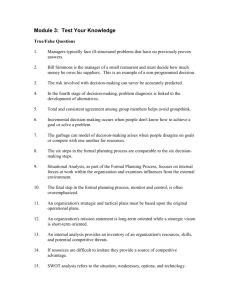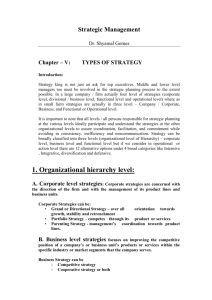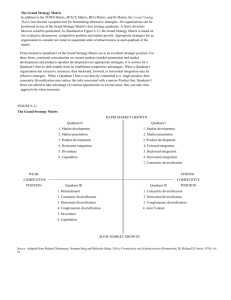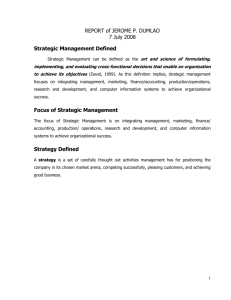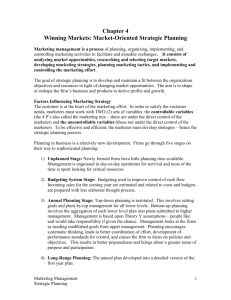10. How does strategic management differ in
advertisement
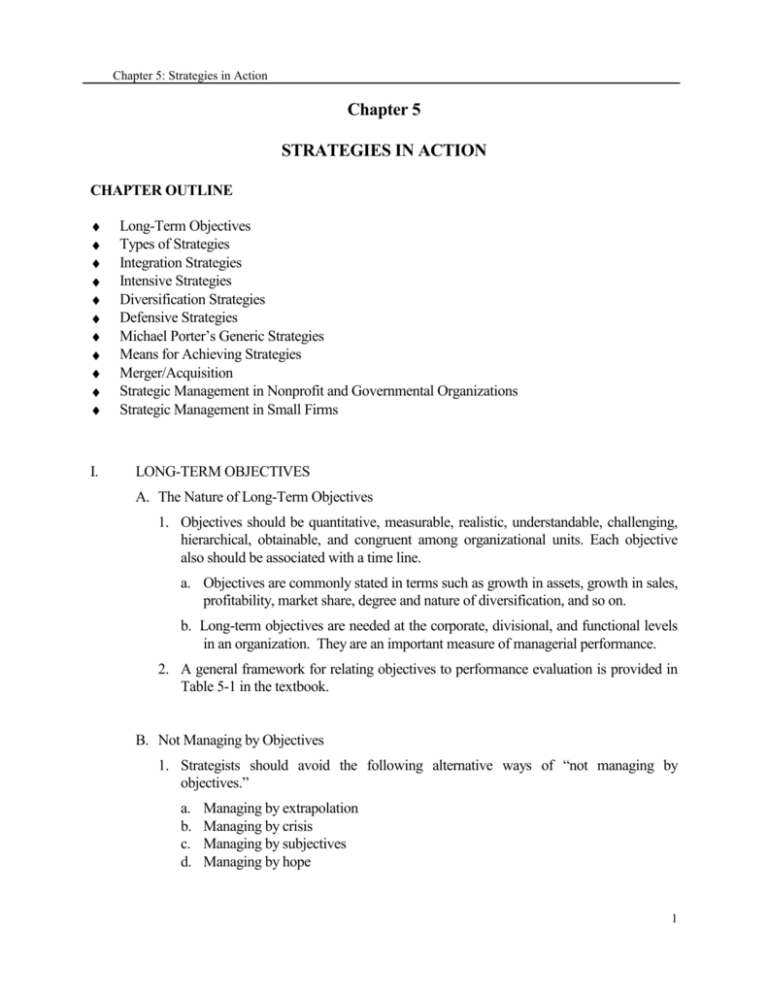
Chapter 5: Strategies in Action
Chapter 5
STRATEGIES IN ACTION
CHAPTER OUTLINE
I.
Long-Term Objectives
Types of Strategies
Integration Strategies
Intensive Strategies
Diversification Strategies
Defensive Strategies
Michael Porter’s Generic Strategies
Means for Achieving Strategies
Merger/Acquisition
Strategic Management in Nonprofit and Governmental Organizations
Strategic Management in Small Firms
LONG-TERM OBJECTIVES
A. The Nature of Long-Term Objectives
1. Objectives should be quantitative, measurable, realistic, understandable, challenging,
hierarchical, obtainable, and congruent among organizational units. Each objective
also should be associated with a time line.
a. Objectives are commonly stated in terms such as growth in assets, growth in sales,
profitability, market share, degree and nature of diversification, and so on.
b. Long-term objectives are needed at the corporate, divisional, and functional levels
in an organization. They are an important measure of managerial performance.
2. A general framework for relating objectives to performance evaluation is provided in
Table 5-1 in the textbook.
B. Not Managing by Objectives
1. Strategists should avoid the following alternative ways of “not managing by
objectives.”
a.
b.
c.
d.
Managing by extrapolation
Managing by crisis
Managing by subjectives
Managing by hope
1
Chapter 5: Strategies in Action
II.
TYPES OF STRATEGIES
A. A Comprehensive Strategic Management Model
1. The model illustrated in Figure 5-1 in the textbook provides a conceptual basis for
applying strategic management.
2. Defined and exemplified in Table 5-2, alternative strategies that an enterprise could
pursue can be categorized into 13 actions—forward integration, backward integration,
horizontal integration, market penetration, market development, product development,
concentric diversification, conglomerate diversification, horizontal diversification,
joint venture, retrenchment, divestiture, and liquidation—and a combination strategy.
3. Each alternative strategy has countless variations. For example, market penetration can
include adding salespersons, increasing advertising expenditures, couponing, and
using similar actions to increase market share in a given geographic area.
III.
INTEGRATION STRATEGIES
A. Forward Integration
1. Forward integration involves gaining ownership or increased control over distributors
or retailers.
2. Six guidelines when forward integration may be an especially effective strategy:
a. When an organization’s present distributors are especially expensive or unreliable,
or incapable of meeting firm’s distribution needs.
b. When the availability of quality distributors is so limited as to offer a competitive
advantage to those firms that integrate forward.
c. When an organization competes in an industry that is growing and expected to
continue to grow markedly.
d. When an organization has both the capital and human resources needed to manage
the new business.
e. When the advantages of stable production are particularly high.
f. When present distributors have high profit margins.
B. Backward Integration
1. Backward integration is a strategy of seeking ownership or increased control of a
firm’s suppliers. This strategy can be especially appropriate when a firm’s current
suppliers are unreliable, too costly, or cannot meet the firm’s needs.
2. Some industries in the United States (such as automotive and aluminum industries) are
reducing their historic pursuit of backward integration. Instead of owning their
suppliers, companies negotiate with several outside suppliers.
3. Outsourcing, whereby companies use outside suppliers, shop around, play one seller
against another, and go with the best deal is becoming widely practiced.
2
Chapter 5: Strategies in Action
C. Horizontal Integration
1. Horizontal integration refers to a strategy of seeking ownership of or increased control
over a firm’s competitors. One of the most significant trends in strategic management
today is the increased use of horizontal integration as a growth strategy. Mergers,
acquisitions, and takeovers among competitors allow for increased economies of scale
and enhanced transfer of resources and competencies.
2. Horizontal integration has become the most-favored growth strategy in many
industries. For example, explosive growth in e-commerce has telecommunications
firms worldwide frantically merging and pursuing horizontal integration to gain
competitiveness.
3. There are five guidelines for when horizontal integration may be an especially
effective strategy:
a.
b.
c.
d.
IV.
When an organization can gain monopolistic characteristics.
When an organization competes in a growing industry.
When increased economies of scale provide major competitive advantages.
When an organization has both the capital and human talent needed to
successfully manage an expanded organization.
INTENSIVE STRATEGIES
A. Market Penetration
1. A market-penetration strategy seeks to increase market share for present products or
services in present markets through greater marketing efforts.
2. Market penetration includes increasing the number of salespersons, advertising
expenditures, and publicity efforts or offering extensive sales promotion items.
3. Five guidelines for when market penetration is especially effective:
a. When current markets are not saturated.
b. When usage rate of current customers could be increased.
c. When market shares of major competitors have been declining while total industry
sales have been increasing.
d. When the correlation between dollar sales and dollar marketing expenditures
historically has been high.
e. When increased economies of scale provide major advantages.
B. Market Development
1. Market development involves introducing present products or services into new
geographic areas.
3
Chapter 5: Strategies in Action
2. The climate for international market development is becoming more favorable. In
many industries, such as airlines, it is going to be hard to maintain a competitive edge
by staying close to home.
3. Six guidelines for when this is may be effective:
a. When new channels of distribution are available that are reliable, inexpensive, and
of good quality.
b. When an organization is very successful at what it does.
c. When new untapped or unsaturated markets exist.
d. When an organization has the needed capital and human resources to manage
expanded operations.
e. When an organization has excess production capacity.
f. When an organization’s basic industry rapidly is becoming global in scope.
C. Product Development
1. Product development is a strategy that seeks increased sales by improving or
modifying present products or services. Product development usually entails large
research and development expenditures.
2. Five guidelines for when to use product development:
a. When an organization has successful products that are in the maturity stage of the
product life cycle.
b. When an organization competes in an industry that is characterized by rapid
technological developments.
c. When major competitors offer better-quality products at comparable prices.
d. When an organization competes in a high-growth industry.
e. When an organization has especially strong research and development capabilities.
V.
DIVERSIFICATION STRATEGIES
A. Concentric Diversification
1. Adding new, but related, products or services is widely called concentric
diversification.
2. Six guidelines for when to use concentric diversification:
a.
b.
c.
d.
When an organization competes in a no-growth or slow growth industry.
When adding new, but related products would enhance sales of current products.
When new, but related products could be offered at competitive prices.
When new, but related products have seasonal sales levels that counterbalance
existing peaks and valleys.
e. When an organization’s products are in the decline stage of the life cycle.
f. When an organization has a strong management team.
4
Chapter 5: Strategies in Action
B. Horizontal Diversification
1. Adding new, unrelated products or services for present customers is called horizontal
diversification. This strategy is not as risky as conglomerate diversification because a
firm already should be familiar with its present customers.
2. Four guidelines for when to use horizontal diversification:
a. When revenues derived from an organization’s current products or services would
increase significantly by adding the new, unrelated products.
b. When an organization competes in a highly competitive and/or no-growth
industry.
c. When an organization’s present channels of distribution can be used to market the
new products to current customers.
d. When the new products have countercyclical sales patterns compared to an
organization’s present products.
C. Conglomerate Diversification
1. Adding new, unrelated products or services is called conglomerate diversification.
2. Some firms pursue conglomerate diversification based in part on an expectation of
profits from breaking up acquired firms and selling divisions piecemeal.
3. General Electric is a classic firm that is highly diversified. GE makes locomotives,
lightbulbs, power plants, and refrigerators; GE manages more credit cards than
American Express and owns more commercial aircraft than American Airlines.
4. Six guidelines explain when it is effective to use conglomerate diversification:
a. When an organization’s basic industry is experiencing declining annual sales and
profits.
b. When an organization has the capital and managerial talent needed to compete.
c. When an organization has the opportunity to purchase an unrelated business that is
an attractive investment.
d. When there exists financial synergy between the acquired and acquiring firms.
e. When existing markets for an organization’s present products are saturated.
f. When antitrust action could be charged against an organization that historically
has concentrated on a single industry.
VI.
DEFENSIVE STRATEGIES
A. Retrenchment
1. Retrenchment occurs when an organization regroups through cost and asset reduction
to reverse declining sales and profits.
5
Chapter 5: Strategies in Action
2. Sometimes called a turnaround or reorganizational strategy, retrenchment is designed
to fortify an organization’s basic distinctive competence.
3. Bankruptcy can be an effective retrenchment strategy.
a. Chapter 7 bankruptcy is a liquidation procedure used only when a corporation sees
no hope of being able to operate successfully or to obtain the necessary creditor
agreements.
b. Chapter 9 bankruptcy applies to municipalities.
c. Chapter 11 bankruptcy allows organizations to reorganize and come back after
filing.
d. Chapter 12 bankruptcy provides special relief to family farmers with debt equal to
or less than $1.5 million.
e. Chapter 13 bankruptcy is similar to Chapter 11 but available only to small
businesses owned by individuals with unsecured debts of less than $100,000 and
secured debts of less than $350,000.
4. Five guidelines when retrenchment may be an especially effective strategy to pursue:
a. When an organization has a clearly distinctive competence but has failed to meet
objectives consistently.
b. When an organization is one of the weaker competitors in a given industry.
c. When an organization is plagued by inefficiency, low profitability, poor employee
morale, and pressure from stockholders to improve performance.
d. When an organization has failed to capitalize on external opportunities, minimize
external threats, take advantage of internal strengths, and overcome internal
weaknesses over time.
e. When an organization has grown so large so quickly that major internal
reorganization is needed.
B. Divestiture
1. Selling a division or part of an organization is called divestiture. Divestiture often is
used to raise capital for further strategic acquisitions or investments.
2. Divestiture has become a very popular strategy as firms try to focus on their core
strengths, lessening their level of diversification. A few divestitures consummated in
2002 are given in Table 5-2 in the textbook.
3. Six guidelines for when to use divestiture:
a. When an organization has pursued a retrenchment strategy and it failed to
accomplish needed improvement.
b. When a division needs more resources to be competitive than the company can
provide.
6
Chapter 5: Strategies in Action
c.
d.
e.
f.
When a division is responsible for an organization’s overall poor performance.
When a division is a misfit with the rest of an organization.
When a large amount of cash is needed quickly and cannot be obtained.
When government antitrust action threatens an organization.
C. Liquidation
1. Selling all of a company’s assets, in parts, for their tangible worth is called liquidation.
Liquidation is recognition of defeat and consequently can be an emotionally difficult
strategy.
2. Three guidelines of when to use liquidation:
a. When an organization has pursued both a retrenchment and a divestiture strategy
and neither has been successful.
b. When an organization’s only alternative is bankruptcy.
c. When the stockholders of a firm can minimize their losses by selling assets.
VII.
MICHAEL PORTER’S GENERIC STRATEGIES
A. Cost Leadership Strategies
1. A primary reason for pursuing forward, backward, and horizontal integration strategies
is to gain cost leadership benefits.
2. Striving to be the low-cost producer in an industry can be especially effective when the
market is composed of many price-sensitive buyers, when there are few ways to
achieve product differentiation, when buyers do not care much about differences from
brand to brand, or when there are a large number of buyers with significant bargaining
power.
3. The basic idea behind a cost leadership strategy is to underprice competitors and
thereby gain market share and sales, driving some competitors out of the market
entirely.
B. Differentiation Strategies
1. A successful differentiation strategy allows a firm to charge higher prices for its
products to gain customer loyalty because consumers may become strongly attached to
the differentiation features.
2. A risk of pursuing a differentiation strategy is that the unique product may not be
valued highly enough by customers to justify the higher price.
3. Common organizational requirements for a successful differentiation strategy include
strong coordination among the R&D and marketing functions and substantial
amenities to attract scientists and creative people.
C. Focus Strategies
7
Chapter 5: Strategies in Action
1. A successful focus strategy depends on an industry segment that is of sufficient size,
has good growth potential, and is not crucial to the success of other major competitors.
2. Strategies such as market penetration and market development offer substantial
focusing advantages.
3. Focus strategies are most effective when consumers have distinctive preferences or
requirements and when rival firms are not attempting to specialize in the same target
segment. Firms pursuing a focus strategy include Midas, Red Lobster, Federal
Express, and Schwinn.
D. The Value Chain
1. According to Porter, the business of a firm can be best described as a value chain in
which total revenues minus total costs of all activities undertaken to develop and
market a product or service yields value.
2. Firms should strive to understand not only their own value chain operations, but also
their competitors’, suppliers’, and distributors’ value chains.
VIII.
JOINT VENTURE/PARTNERING
A. Joint Venture
1. Joint venture is a popular strategy that occurs when two or more companies form a
temporary partnership or consortium for the purpose of capitalizing on some
opportunity.
2. Other types of cooperative arrangements include R&D partnerships, cross-distribution
agreements, cross-licensing agreements, cross-manufacturing agreements, and jointbidding consortia.
3. Joint ventures and cooperative arrangements are being used increasingly because they
allow companies to improve communications and networking, to globalize operations
and minimize risk.
4. Many, if not most, organizations pursue a combination of two or more strategies
simultaneously, but a combination strategy can be exceptionally risky if carried too far.
No organization can afford to pursue all the strategies that might benefit the firm.
Difficult decisions must be made. Priorities must be established. Organizations, like
individuals, have limited resources. Both organizations and individuals must choose
among alternative strategies and avoid excess indebtedness.
5. Joint ventures may fail when:
a. Managers who must collaborate regularly are not involved in the venture.
b. The venture may benefit partnering companies but not the customers.
8
Chapter 5: Strategies in Action
c. Both partners may not support the venture equally.
d. The venture may begin to compete with one of the partners.
The following guidelines are appropriate to prevent the failure:
a. First, avoid regions with ethnic conflicts and violence.
b. Second, make sure the potential partner has a proper charter that has been
amended to permit joint venture participation.
c. Third, be aware that businesspeople in these lands have little knowledge of
marketing, contract law, corporate law, fax machines, voice mail, and other
business practices that Westerners take for granted.
IX.
MERGER/ACQUISITION
A. Mergers and acquisitions are two commonly used ways to pursue strategies.
1.
A merger occurs when two organizations of about equal size unite to form one
enterprise.
2.
An acquisition occurs when a large organization purchases (acquires) a smaller firm
or vice versa.
B. There are many reasons for mergers and acquisitions, including the following:
a.
b.
c.
d.
e.
f.
g.
h.
To provide improved capacity utilization.
To make better use of an existing sales force.
To reduce managerial staff.
To gain economies of scale.
To smooth out seasonal trends in sales.
To gain access to new suppliers, distributors, customers, products, and creditors.
To gain new technology.
To reduce tax obligations.
C. Leveraged Buyouts (LBOs)
1. An LBO occurs when a corporation’s shareholders are bought out (hence buyout) by
the company’s management and other private investors using borrowed funds (hence
leveraged).
2. Besides trying to avoid a hostile takeover, other reasons for the initiation of an LBO by
senior management are that particular divisions do not fit into an overall corporate
strategy, must be sold to raise cash, or receive an attractive offering price. A LBO
takes a corporation private.
X.
STRATEGIC MANAGEMENT IN NONPROFIT AND GOVERNMENT
9
Chapter 5: Strategies in Action
ORGANIZATIONS
A. Educational Institutions
1. Educational institutions are using strategic-management techniques and concepts more
frequently.
2. For a list of college strategic plans, click on strategic-planning links found at the
{http://www.strategyclub.com} website and scroll down through the academic sites.
B. Medical Organizations
1. Hospitals—originally intended to be warehouses for people dying of tuberculosis,
smallpox, cancer, pneumonia, and infectious diseases—are creating new strategies
today as advances in the diagnosis and treatment of chronic diseases are undercutting
that earlier mission.
2. A successful hospital strategy for the future will require renewed and deepened
collaboration with physicians, who are central to hospitals’ well-being, and a
reallocation of resources from acute to chronic care in home and community settings.
3. Current strategies being pursued by many hospitals include creating home health
services, establishing nursing homes, and forming rehabilitation centers.
C. Government Agencies and Departments
1. Federal, state, county, and municipal agencies and departments, such as police
departments, chambers of commerce, forestry associations, and health departments are
responsible for formulating, implementing, and evaluating strategies that use
taxpayers’ dollars in the most cost-effective way to provide services and programs.
2. Strategic-management concepts are increasingly being used to enable governmental
organizations to be more effective and efficient.
XI.
STRATEGIC MANAGEMENT IN SMALL FIRMS
A major conclusion of the literature is that the lack of strategic management knowledge is a
serious obstacle for many small business owners. Other problems often encountered when
applying strategic-management concepts to small businesses are a lack of both sufficient
capital to exploit external opportunities and a day-to-day cognitive frame of reference.
Research also indicates that strategic management in small firms is more informal than in
large firms, but small firms that engage in strategic management outperform those that do not.
ISSUES FOR REVIEW AND DISCUSSION
1. How does strategy formulation differ for a small versus large organization? For a for-profit
versus a nonprofit organization?
10
Chapter 5: Strategies in Action
Answer: Strategy formulation is conceptually the same for both small and large organizations.
However, for large firms, there are more variables to include in both the external and internal
audits. The process is usually more formal in a large firm.
2. Give recent examples of market penetration, market development, and product
development.
Answer: Market penetration means selling more product to existing markets. The class will likely
think of several examples but some possibilities include Sony lowering the price on its Gameboy
in order to increase selling. Market development means selling an existing product to a new
market. Sony has developed several robots for its Japanese market. It is now seeking to develop a
market for robotics in U.S. households. Product development means selling a new product to an
existing market. An example of this is Swiffer Sweeper developing the mopping version of its
sweeper.
3. Give recent examples of forward integration, backward integration, and horizontal
integration.
Answer: Forward integration means purchasing or developing a distributor for a product. For
instance, Nike now has its own retail stores in various locations. Backward integration means
owning a supply source for production. For instance, recently garment producers in Sri Lanka
began seeking to purchase textile mills in India. Horizontal integration means acquiring like
operations. For instance, a hospital group may purchase another hospital. Ask the class for current
examples.
4. Give recent examples of concentric diversification, horizontal diversification, and
conglomerate diversification.
Answer: Concentric diversification means adding new, but related products. For instance, when
telephone companies and cable firms offered Internet access, this represented concentric
diversification. Horizontal diversification means adding new, unrelated products for customers.
For instance, Amazon.com originally offered books and CDs. Now its assortment is huge with
kitchen sections, auction sections, etc. Conglomerate diversification is similar but also seeks new
customers. For instance, Reader’s Digest launched a gift-giving business. Ask the class for current
examples.
5. Give recent examples of joint venture, retrenchment, divestiture, and liquidation.
Answer: Students will have a variety of answers, but here are some examples. Movielink is a
joint venture by five major movie studios aimed at creating an Internet video-on-demand
service. Arthur Anderson is currently undergoing a retrenchment strategy, as are many
airlines. Lockheed’s sale of Comstat is an example of a divestiture. Federated Department
Stores e-Commerce Division is undergoing liquidation. Consider asking students which of
these best represents K-mart’s current strategy.
6. Read one of the suggested readings at the end of this chapter. Prepare a five-minute oral
report on the topic.
11
Chapter 5: Strategies in Action
Answer: This is a worthwhile library exercise.
7. Do you think hostile takeovers are unethical? Why or why not?
Answer: It can best be argued that hostile takeovers are ethical. Usually, only weak companies
face hostile takeovers, and, typically, shareholders and customers of the company benefit from the
new organization. Most employees and managers benefit, too, but some employees and top
managers usually lose their jobs when the takeover is consummated. From this angle, some
students may argue that hostile takeovers are unethical.
8. What are the major advantages and disadvantages of diversification?
Answer: Several disadvantages of diversification are (1) it is risky, (2) it is costly, (3) it requires
excellent management skills, and (4) it requires an elaborate control system. Some of the
advantages of diversification are (1) it allows a firm to spread risks and resources in more than one
area, (2) it allows a firm to pursue special opportunities in diverse areas, and (3) it allows a firm to
balance counterseasonal sales yearly.
9. What are the major advantages and disadvantages of an integrative strategy?
Answer: One advantage of an integrative-type strategy is that it allows a firm to offer products and
services at lower prices. A disadvantage of integrative-type strategies is that firms can be trapped
if their basic industry falters.
10. How does strategic management differ in profit and nonprofit organizations?
Answer: The strategic-management process is conceptually the same for both profit and nonprofit
organizations. However, compared to profit firms, nonprofit organizations often function in a
monopolistic environment, produce a product or service that offers little or no performance
measurability, and may be totally dependent on outside sources of financing. Thus, the types of
variables examined will differ between profit and nonprofit organizations.
11. Why is it not advisable to pursue too many strategies at once?
Answer: Organizational resources are spread too thin when more than a few strategies are pursued
at the same time. All organizations have limited resources. No organization can pursue all the
strategies that may benefit the firm. Similarly, no individual can take on an unlimited amount of
debt to obtain goods and services. No more than a few strategies can be financed, marketed, and
managed effectively at the same time. Some practitioners say only a single strategy should be
pursued at a given time by a single organization.
12. Consumers can purchase tennis shoes, food, cars, boats, and insurance on the Internet. Are
there any products today that cannot be purchased online? What is the implication for
traditional retailers?
Answer: There are very few, if any, products that cannot be purchased online. Experts disagree on
the implications of the online purchasing of products and services for traditional retailers. Some
experts point to the efficiencies associated with e-commerce and the Internet and believe that an
12
Chapter 5: Strategies in Action
increasing portion of the goods and services purchased each year will be done online. Other
experts disagree and believe that the Internet will not threaten traditional retailers in a substantive
manner. Ask your students to share their opinions regarding the future of e-commerce in the
United States and abroad.
13. Do you feel Internet sales should remain tax free? What are the pros and cons of Internet
commerce remaining a tax free haven?
Answer: Allowing Internet purchases to be tax free provides an incentive for people to shop
online. This is important as the Internet grows as a viable distribution channel. However, critics of
tax-free Internet shopping point out the implications for government sources of revenue and
competition. Every tax-free dollar spent online represents lost revenue for government. In
addition, brick-and-mortar stores suffer as it makes the Internet more competitive.
14. What are the pros and cons of a firm merging with a rival firm?
Answer: The following are some pros and cons of merging.
Pros:
To provide improved capacity utilization.
To make better use of an existing sales force.
To reduce managerial staff.
To gain economies of scale.
To smooth out seasonal trends in sales.
To gain access to new suppliers, distributors, customers, products, and creditors.
To gain new technology.
To reduce tax obligations.
Cons:
It is difficult to place an accurate value on a company; as a result, there is a risk that the
acquiring company will overpay for acquired company.
Firms lose flexibility as they get larger.
The merged firm must effectively combine two previously separate firms, with separate
cultures and organizational routines.
Some high-performing employees may leave the merged firm as a result of uncertainties about
their future.
13
